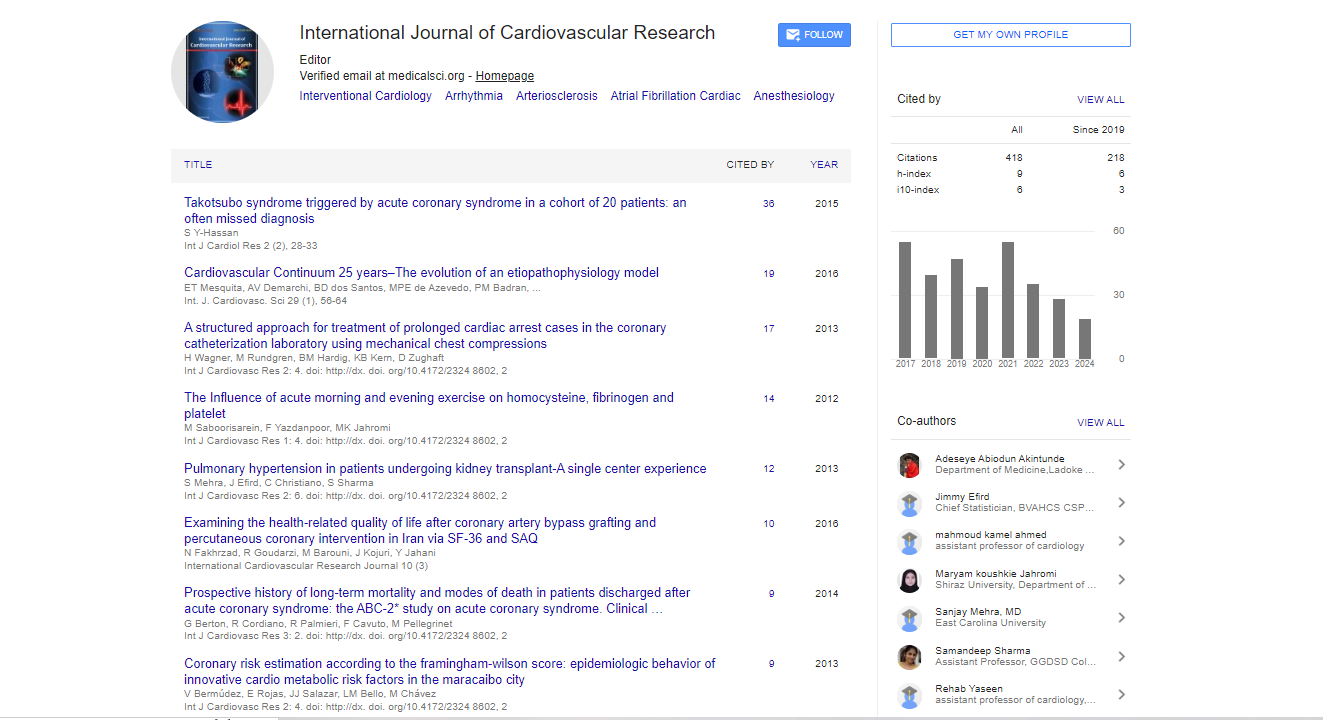Opinion Article, Int J Cardiol Res Vol: 13 Issue: 4
Advances in Cardiac Intervention: From Stent Design to Complex Procedures
John Smith*
1Department of Cardiology, Brigham and Women's Hospital, Boston, United States of America
*Corresponding Author: John Smith,
Department of Cardiology, Brigham and
Women's Hospital, Boston, United States of America
E-mail: john.smith@hms.harvard.edu
Received date: 15 July, 2024 Manuscript No. ICRJ-24-148906;
Editor assigned date: 17 July, 2024, PreQC No. ICRJ-24-148906 (PQ);
Reviewed date: 31 July, 2024, QC No. ICRJ-24-148906;
Revised date: 07 August, 2024, Manuscript No. ICRJ-24-148906 (R);
Published date: 14 August, 2024, DOI: 10.4172/2324-8602.1000571
Citation: Smith J (2024) Advances in Cardiac Intervention: From Stent Design to Complex Procedures. Int J Cardiol Res 13:4.
Description
Interventional cardiology has revolutionized the management of cardiovascular diseases over the past few decades, offering minimally invasive alternatives to traditional surgery. Among the most notable advancements are the development of coronary stents, devices used to keep arteries open after angioplasty. Stents have dramatically reduced the need for open-heart surgery and improved patient outcomes, especially for those with Coronary Artery Disease (CAD). However, the field of interventional cardiology has continued to evolve, moving beyond traditional stents to embrace newer technologies that address limitations of earlier devices and offer enhanced therapeutic benefits. The first stents, known as Bare Metal Stents (BMS), were metallic mesh like structures deployed to maintain the patency of the coronary artery after angioplasty. While they reduced elastic recoil and vessel collapse, restenosis remained a challenge, occurring in about 20%-30% of cases due to neointimal hyperplasia, where smooth muscle cells proliferate within the stent. Over time, Drug Eluting Stents (DES) technology has continued to evolve to address these concerns. Second and third generation DES now feature thinner stent struts, more biocompatible polymers and improved drug-release kinetics. These innovations have further reduced the risk of stent thrombosis and restenosis, making Percutaneous Coronary Intervention (PCI) even safer and more effective.
One notable advancement is the use of bioresorbable polymers. Traditional DES employed permanent polymers to control drug release, but these materials could trigger long term inflammation and delayed endothelial healing. Bioresorbable polymers degrade over time, leaving behind only the metallic stent structure and reducing the risk of adverse reactions. Additionally, newer-generation DES use drugs with more targeted mechanisms of action and reduced systemic side effects, such as everolimus or zotarolimus. Despite these advancements, there remain patients for whom traditional metallic DES may not be ideal. Some may experience stent fracture, impaired vessel flexibility, or chronic inflammation due to the presence of a permanent metallic scaffold. These limitations have spurred the development of novel alternatives, such as bioresorbable stents and polymer-free stents. Bioresorbable Vascular Scaffolds (BVS) represent a significant leap in interventional cardiology. Unlike traditional stents that permanently remain in the artery, BVS are designed to dissolve over time, leaving the artery free of any foreign material. This theoretically allows the artery to regain its natural flexibility and function without the long-term risks associated with metallic implants. The first commercially available BVS, known as Absorb (Abbott Vascular), was made from a polymer called Poly-L-Lactic Acid (PLLA), which degrades over approximately two years. Initial enthusiasm for BVS was high due to their potential to eliminate late stent thrombosis and restore natural vessel function. However, early trials showed higher rates of thrombosis and restenosis compared to modern DES, largely due to thicker struts and suboptimal implantation techniques.
While Absorb was eventually withdrawn from the market, study into BVS continues. Newer generation scaffolds feature thinner struts, improved mechanical strength and more favorable drug-release profiles. Additionally, advances in imaging techniques, such as Optical Coherence Tomography (OCT) and Intravascular Ultrasound (IVUS), have improved the precision of BVS implantation, potentially reducing the risk of complications. BVS remain a promising technology, especially for younger patients or those with long life expectancies, where the need for permanent metallic implants is less desirable. The future of interventional cardiology extends beyond stents and frameworks. Several emerging technologies hold promise for further improving patient outcomes and expanding the scope of minimally invasive cardiovascular procedures. Trans catheter Aortic Valve Replacement (TAVR) has transformed the treatment of aortic stenosis, particularly in high-risk patients who are not candidates for open heart surgery. As technology advances, TAVR is being applied to lower-risk populations and may eventually become the standard treatment for aortic stenosis. Lithotripsy for calcified lesions in patients with heavily calcified coronary arteries, traditional PCI can be challenging. Intravascular Lithotripsy (IVL) uses sound waves to break up calcium deposits, allowing for more effective stent placement and reducing the risk of stent failure. Robotic systems are being developed to enhance precision during PCI, reducing operator fatigue and potentially improving outcomes. These systems allow for remote controlled stent deployment, with enhanced imaging and navigation capabilities.
Conclusion
The field of interventional cardiology has made significant strides over the past few decades, with coronary stents at the frontline of these advancements. From bare-metal stents to drug-eluting stents and bioresorbable structures, each new generation of technology has improved patient outcomes and reduced complications. While challenges remain, particularly with newer technologies such as bioresorbable stents, ongoing study and innovation continue to push the boundaries of what is possible in the treatment of coronary artery disease. As interventional cardiology moves beyond stents, the future holds exciting possibilities for minimally invasive cardiovascular care, improving both the safety and efficacy of procedures for millions of patients worldwide.
 Spanish
Spanish  Chinese
Chinese  Russian
Russian  German
German  French
French  Japanese
Japanese  Portuguese
Portuguese  Hindi
Hindi 



